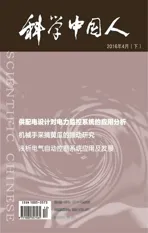The solutions for rate equations of lasers with initial and boundary conditions based on diffusion equation
2016-09-07MengbinLiXiaoxiaoMaJingWangSchoolofPhysicsandTechnologyUniversityofJinan
Mengbin Li,Xiaoxiao Ma,Jing WangSchool of Physics and Technology,University of Jinan
The solutions for rate equations of lasers with initial and boundary conditions based on diffusion equation
Mengbin Li,Xiaoxiao Ma,Jing Wang
School of Physics and Technology,University of Jinan
The rate equations describing a solid-state laser are de⁃rived from diffusion equation.To settle the equations,a LD pumped Q-switched laser is considered.With the initial and boundary condi⁃tions,the photon intensityϕ(r,t)and population inversion n(r,t)are obtained.The calculated values fit the experimental results well.
diffusion equation;rate equations;initial and bound⁃ary conditions
1.ITRODUCTION
Heat conduction equation or particle diffusion equation is one of three kinds of classical equation in Methods of Mathematical Physics. It has wide application in solving mathematical physics equation[1,2],such as solving the one-dimensional heat conduction problems,parti⁃cle diffusion in the medium as well as the option problems in financial mathematics and so on.The rate equations of laser describe the distri⁃bution of the photon density inside the resonant cavity,which are gen⁃erally derived by the particle number of each energy level changing with time.However,given the gain and loss of photon number in reso⁃nant cavity,the rate equations actually can be obtained from particle diffusion equation based on the quantum theory.Definite condition is essential to solve the mathematical equation.The initial working sta⁃tus and the photon density spatial distribution of the laser influence greatly solvingthe rate equations of different cavity.
In this paper,rate equations of solid-state laser can be decided by the diffusion equation,and the definite condition of the specific re⁃search problem is confirmed.The theoretical calculated value of the photon density distribution function is obtained by programming.
2.THE RATE EQUATION OF LASER
Diffusion equation is considered as following.[1]
u(r,t)is the particle number concentration related to space r and time t,f(r,t)is diffusion source intensity;u(r,t)are replaced by pho⁃ton densityϕ(r,t),gain factor G is on behalf of the gain of laser cry⁃stal for light.The loss in cavity is represented by δ,and then the inho⁃mogeneous term can be expressed by
Combining Eq.(1)with Eq.(2),the distribution equation of laser intracavity photon density can be obtained.
The equation of population inversion density of intracavity laser gain medium is considered.
n(r,t)is population inversion density of active medium.Rinis pumping rate,both of it and the stimulated cross section of active me⁃dium are related to pump power.
Eqs.(3)and(4)form rate equations of general solid-state laser.
3.INITIAL AND BOUNDARY OF RATE EQUATIONS
To settle the equation of the photon density distribution,under⁃standing the specific spatial distribution of photon number and the ini⁃tial state of laser is very important.A specific laser,that is LD pumped acoustic-optic(AO)Q-switched solid-state laser,is taken into ac⁃ count.Pumped by 808nm laser,the Nd:GdVO4crystal can generate 1064nm laser.The cavity length M1M2is 18cm.Effective length of crys⁃tal of AO switch is 24 mm and the repetitive frequency of switch is 10kHz,Figure 1 schematically shows the experimental setup.
The spatial distribution of the laser diode pumping light in the space is generally regarded as Gaussian distribution,it has been proved in experiments[4,5].
Light intensity of Gaussian beam can be expressed as
I0(z)is the light intensity of r=0.The value ofωin the laser cavity is normally regarded as a constant.Therefore,Eq.(5)can be rewritten as
Fig.2 shows light intensity spacial distribution under the Gauss⁃ian approximation.The horizontal axis is the ratio of the distance be⁃tween the point in the cavity and the optical axis to the beam radius. The vertical axis is normalized intensity of light intensity.
Eq.(6)shows that if laser operates in TEM00mode,intracavity photon density can be approximated as[6,7]
Here,φ(0,t)is the photon density on the optical axis.ωlis the average waist radius of fundamental mode,which is determined by the structure of laser resonant cavity.
As is known,Eq.(7)is a function which is the photon density changing with space,therefore,equation(3)can be rewritten as the
form of partial differential equation only changingwith time.
To think over the longitudinal distribution of photon density along the laser cavity and ensure that laser beam presents Gaussian spatial distribution during Q switch,the integralon the beam cross section should be assumed to be a constant,then Eq.(8) can be rewritten as
When laser began to work,intracavity photon density and popula⁃tion inversion density is approximate 0.Thus when programming equa⁃ tion,initial conditionsare quoted.
4.Experimental Verification of Theoretical Results
In order to verify the rate equation(9)and(4),experimental setup can be established like Fig.1.The output laser waveform was mea⁃sured when laser stably worked,which is the figure of light intensity changingwith time in output position and is compared with the theoret⁃ical value of the rate equation.Parameter values in table 1 are used in equation.

Table 1.The parameters of rate equation
The theoretical values can be obtained when the values in table 1 are plugged into Eq.(4)and Eq.(9),as is shown in Fig.3.
The calculated values fit the experimental results well and it can be seen from Fig.3.
5.CONCLUSION
The rate equations describing a solid-state laser are derived from diffusion equation.To solve the equations,a LD pumped Q-switched laser is considered.With the initial and boundary conditions,the pho⁃ton intensity and population inversion are obtained.The calculated val⁃ues fit the experimental results well.
6.ACKNOWLEDGE
This work is supported by the National Science Foundation of China(61308057)and the Educational-Research Foundation of the University of Jinan(J1341).
REFERENCES:
[1]Kunmiao Liang,Methods of Mathematical Physics(Third Edi⁃tion),Beijing:Higher Education Press,1998,237-243(in Chinese)
[2]Shi Shen,Methods of Mathematical Physics,Shanghai:Tongji University Press,2002,108-110(in Chinese)
[3]Qingpu Wang,Shengzhi Zhao,Xingyu Zhang,Laser Physics, Jinan:ShangdongUniversity Press,1993,Chapter Four.(in Chinese)
[4]Baoquan Yao,Yuezhu Wang,Qiang Liu,Qi Wang,“Study of the Spatial Beam Quality of KTP Optical Parametric Oscillator”,Chi⁃nese Lasers,28:693-697(2001)(in Chinese)
[5]J.Miao,B.Wang,J.Peng,H.Tan,and H.Bian,“Highly stable and efficient KTP-based intracavity optical parametric oscillator with a diode-pumped passively Q-switched laser”,Appl.Phys.B,88:193-196(2007).
[6]G.Boyd and D.Kleinman,“Parametric interaction of focused Gaussian light beams”,IEEE J.Quan.Electron,4:353-353(1968).
[7]G.McAllister,M.Mann,and L.DeShazer,“Transverse-mode distortions in giant-pulse laser oscillators”,IEEE J.Quan.Electron, 6:44-48(1970).
李梦彬(1995-),济南大学物理科学与技术学院在读本科生;
马笑笑(1994-),济南大学物理科学与技术学院在读本科生;
王静(1979-),女,汉族,山东烟台人,副教授,博士,研究方向为数学物理教学方法研究、激光及非线性研究。
